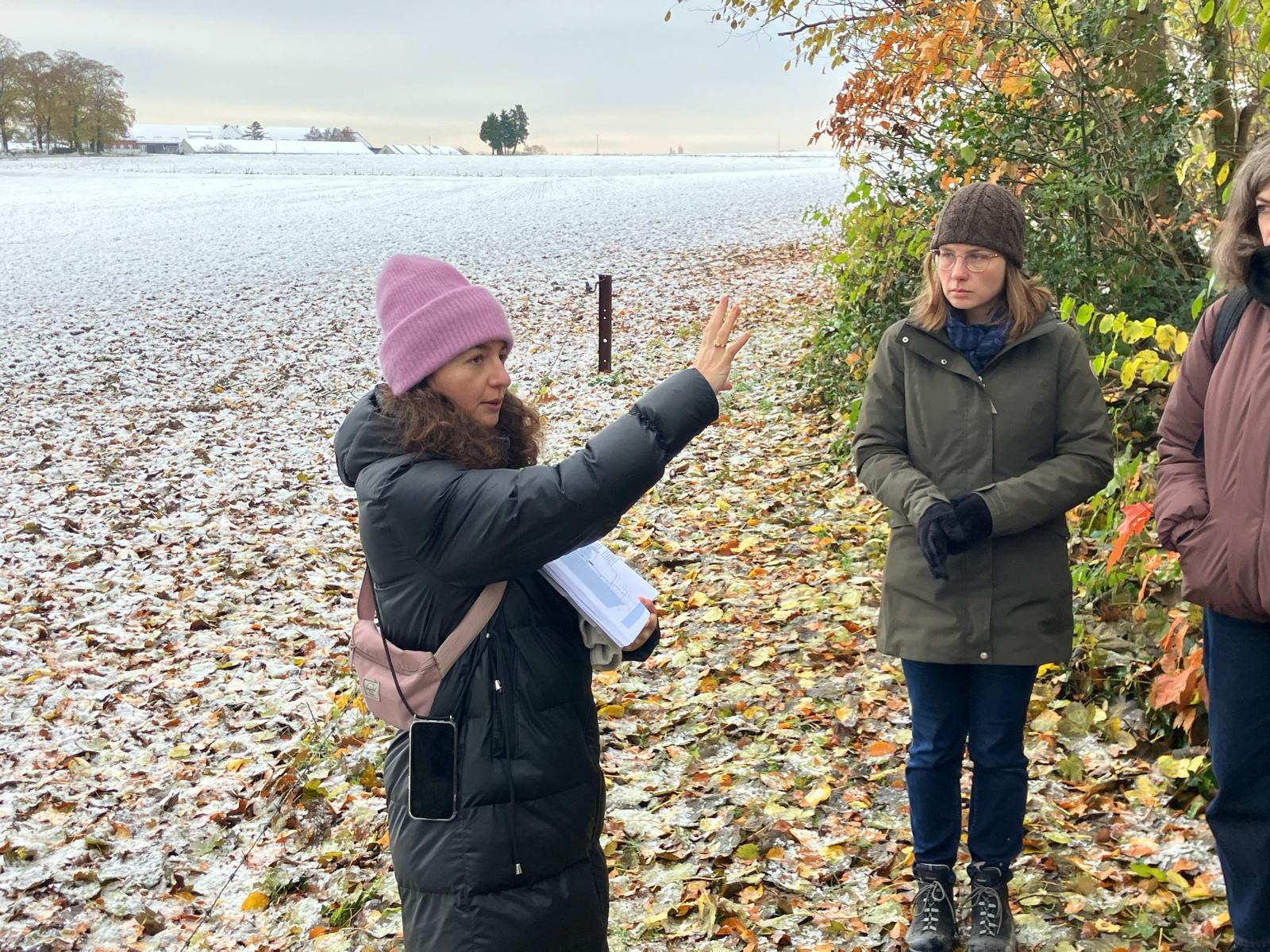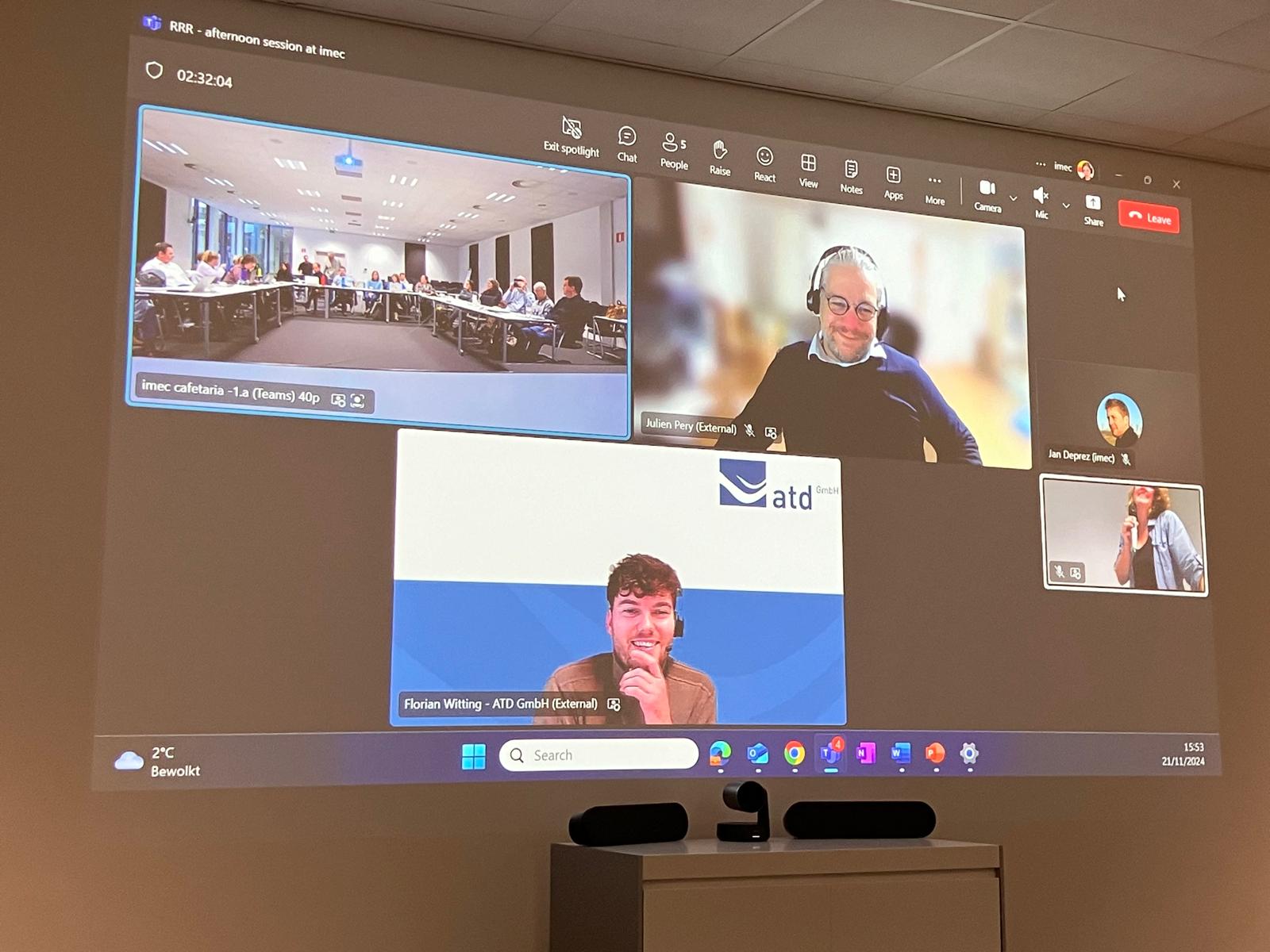Snow and ice surprised the company attending the second Rural Roadwater Rescue fieldtrip 21 November 2024 at Bertem, Belgium. Rubber boots seemed not to be the right choice for footwear as the soil on the roadside from highway E40 had turned from muddy to solid overnight. Many rubber boots were seen jumping up and down keeping the feet warm while the Flemish Authority for Roads and Traffic explained the technicalities of the road runoff basin.
The concrete basin receives water from 3 km highway. Measurements show that the first ten minutes of rain delivers the most polluted runoff, A large part of the pollutants remains in the silt in the basin. Although the basin has not been thoroughly maintained for years it still functions well as a pollutant trap. From the basin the water can be transferred to an artificial meander with swamp vegetation to further clean the water. Next the water can be led to the river Voer.
The Flemish experiences will be part of the Rural Roadwater Rescue final report.
Can road runoff restore the Bukenbeek?
East of Bertem highway E40 crosses Heverlee forest. In the past the forest has been the source of the river Bukenbeek, where horticulture in the area relied on. The source however fell dry, and in time the river transformed into a narrow stream, often invisible due to increased building.

Simona Nikova of the province of Vlaams Brabant has her roots in this area and tries to connect all parties to restore the Bukenbeek. To realize this and other landscape restoration initiatives regional and local governments founded the strategic project Walden.
Simona considers the foreseen renewal of the highway bridge at Heverlee as a chance to lead roadwater to the Heverlee forest and the Bukenbeek. The highway as a tool to restore the local landscape. How to design the bridge to lead the runoff to Heverlee forest? Can the polluted water be received and cleaned as the forest is protected by European Nature directives? Simona hopes that the outcome of the Rural Roadwater Rescue project will contribute to answering these questions and more.
Magnificent road works of Antwerp
Completing the traffic ring of Antwerp is possibly the largest infrastructural project in Europe. The Oosterweel project consists of several new to be built tunnels, of which the Scheldetunnel – crossing the river Schelde – is the largest. At several locations the traffic ring will be covered by new city parks. Many kilometers of new bicycle lanes will be built as well as several Park+Rides to stimulate modal shift. The project is meant to solve the traffic jams and improve the environmental quality in the city of Antwerp and is expected to be finalized in 2030.
Ingrid Cattrel – teamleader water, infrastructure and nature at Lantis – welcomed the Rural Roadwater Rescue company at the impressive building site of the Scheldetunnel. The tunnel consists of eight elements with a total length of 1,8 kilometer and three lanes per direction. Lantis has been founded to realize these infrastructural works of Antwerp. Collecting and cleaning road runoff is an important issue in constructing the traffic ring. An already existing basin is heavily contaminated by Pfas and should be remediated. Ingrid is very much interested in applying – elements of – the Rural Roadwater Rescue strategy to find ways to deal with runoff from the roads still to be constructed.
Progress at partner meeting
Visits to sites where alternated by working sessions indoors. Live working sessions offer the opportunity to extensively debate the progress and future steps. The working session on the progress has been hosted by the province of Vlaams Brabant and attended by Eva Clymans of the Joint Secretary of Interreg Northwest Europe. The working session on future steps has been hosted by IMEC, research center for nano-electronica an digital technology. The full three day program has been organized by the Vlaamse Milieumaatschappij.

Well on track
After all the discussions we can say that Rural Roadwater Rescue is well on track. The first deliverable – the scoping report – has been finalized recently. The report gives an overview of insights in each of the seven elements for a balanced road water management of the partners and their network. These steps are: prevention, collection, cleaning/treatment, storage, distribution, use/re-use and ecosystem balance. The report is the starting point for follow up gathering of knowledge and experience in legal frameworks and practical solutions. The works on these deliverables started in Leuven.

Field trip November 2024 in Flanders